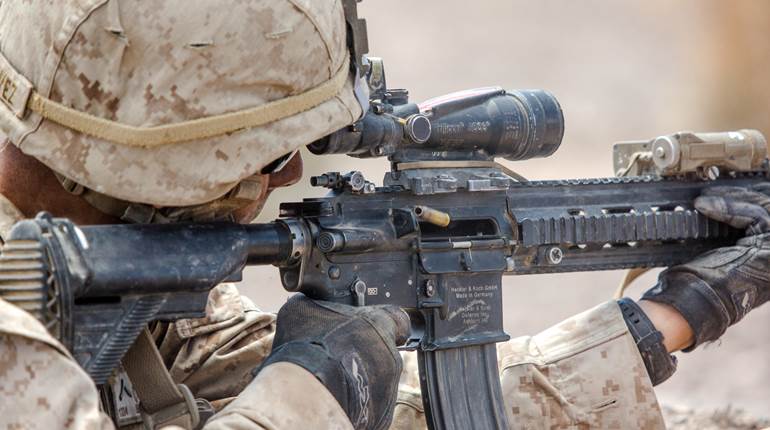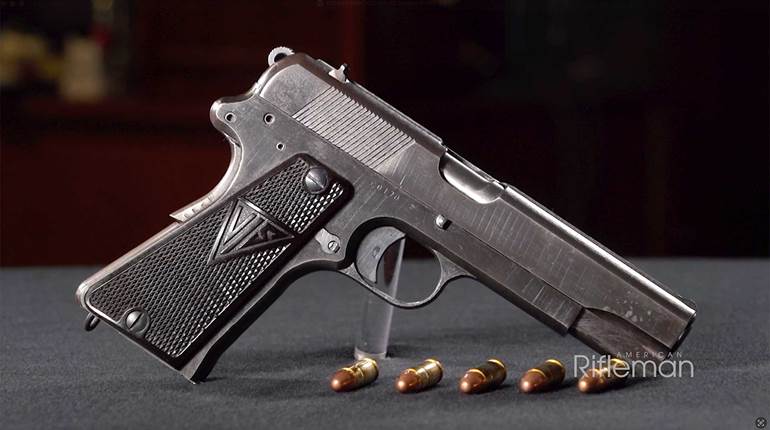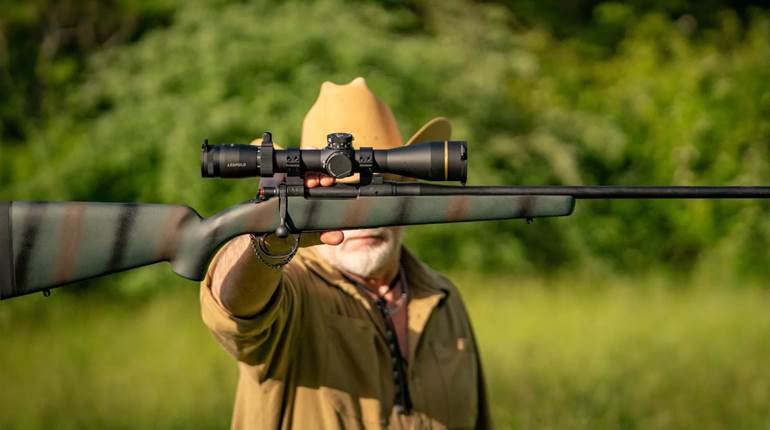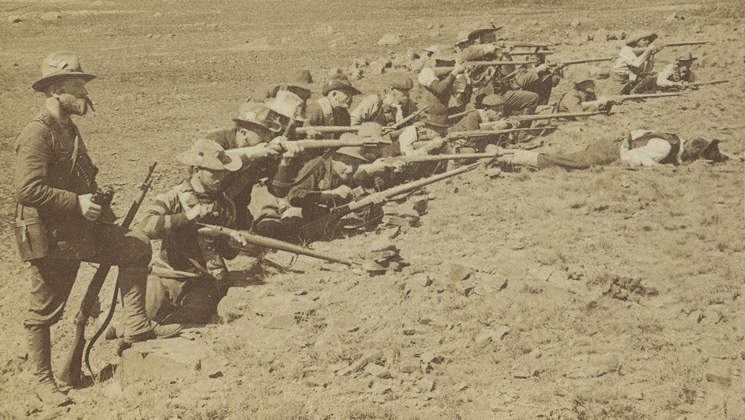
The Irish Transvaal Brigade is seen here carrying several types of Mauser rifles and Martini-Henrys, as well as captured British Lee-Metfords or Enfields. Several volunteer groups of different nationalities fought alongside the Boers.
Throughout all of military history, there are few instances in which rifle marksmanship has played such a significant role as it did in the Second Anglo-Boer War at the turn of the 20th century. The prowess of the Boer burghers (“citizens”) at long-range shooting stopped the juggernaut of the British Empire in its tracks (at least for a time) and astonished observers around the world. While the majority of the unpaid Boer militiamen, serving in small mounted units (“commandos”), were armed with the most modern of repeating bolt-action rifles, and firing smokeless powder cartridges, quite a few of the burghers were also armed with an interesting array of obsolescent firearms.
In order to put these arms in context, it is necessary to take just a moment to delve into the causes of the conflict and to give a very brief overview of the course of the war. Strict, God-fearing Calvinists, the Boers (“farmers”) traced their roots back to an outpost of Dutch (and later also French Huguenot) settlers established at the southern tip of Africa in the 17th century to resupply Dutch ships on their voyages to and from the Dutch East Indies. The British seized the Cape Colony (named for the Cape of Good Hope) during the Napoleonic Wars, and shortly thereafter, tensions rose between the British and the fiercely independent Boers. By the 1830s and 1840s, groups of Boers were moving northward into the interior of Africa by ox-drawn wagon trains (much the same as was seen in the American West at that same time), in order to live their lives as they saw fit. After defeating hostile native tribes, they eventually established two independent republics—the Orange Free State and the Transvaal (also known by its official title of the South African Republic)—finally out of the reach (or so they thought) of the British.

British imperialism, however, was in full swing during the Victorian period, and the British kept grabbing more land from the Boers, even briefly annexing the Transvaal in 1880, only to be defeated the next year by the Boers in what became known as the First Anglo-Boer War. Whereas the discovery of diamonds in 1867 had begun to change the face of the Boer’s rural and simple life by the 1880s, the discovery of gold on the Witwatersrand, near the Transvaal’s capital in 1886, doomed the Boers’ hopes of maintaining their way of life. As was seen in California in the 1850s, in Australia in the 1860s, and would later be seen in the Klondike in 1898, thousands of foreign adventurers flocked to the new city of Johannesburg. They brought with them all of the vices of a boomtown, and they threatened to overwhelm the Boer culture by a sheer weight of numbers if given the franchise to vote.
In a series of manipulative moves, the local British imperialists, with the tacit support of the British government in London, pushed the Boers into an untenable position, while drumming up support from both Conservatives and Liberals in Britain by invoking imperial benefits to “backwards” cultures, as well as hypocritically accusing the Boers of mistreating the native peoples, among other supposed transgressions. Ostensibly, the British demand was to gain the vote for the Uitlanders (“Outsiders”—mainly British) working in the mines, although it was really the mine owners—not the miners—who wanted the vote. However, the real aim was to control the Boers, and although he had offered a number of concessions, by the summer of 1899, the Transvaal’s president, “Oom Paul” (“Uncle Paul”) Kruger could truthfully tell the British negotiators: “It is my country that you want.”
Realizing that there was no use in further negotiations, and that they could not wait until the British reinforcements already at sea reached South Africa, the Boers struck first, declaring war on Britain and invading the neighboring British province of Natal in October 1899. After a few minor setbacks, they laid siege to Ladysmith (the second largest town in the province) and the diamond town of Kimberley far to the south, as well as to a small town on the northwestern edge of the Orange Free State border, Mafeking. Interestingly, the future founder of the Boy Scout movement, Col. Robert Baden-Powell, commanded the defenders at Mafeking. Unfortunately for the Boers, their strategy of taking on these sieges, and not simply bypassing the strong points and striking farther south, sealed their fate. After a failed attempt to raise the siege of Ladysmith, and several other noteworthy defeats in late 1899, the British concentrated their now greatly reinforced army. Under new command, it gradually, and at great cost, pushed the Boer forces back through the Orange Free State and the Transvaal. By the summer of 1900, it had finally conquered all of the Boers’ territory. Valor was not wanting on either side throughout the fighting.
However, while about half of the Boers agreed to lay down their arms (the Handsoppers), the rest of them determined to fight to the end as guerillas. The highly mobile Bitterenders fought a series of brilliant actions with whatever arms they could capture and, by the end of the war in 1902, they were nearly exclusively using British firearms. When captured .303 British ammunition ran scarce, the Boers even scavenged “dropped” cartridges in former British camps. Only the implementation of an extensive system of fortified blockhouses, connected by belts of barbed wire, and a ruthless official program of scorched-earth policies (including civilian “concentration camps”) finally brought the Bitterenders to the peace table.
During the fighting, many British officers commented on the Boers’ incredible marksmanship skills. Indeed, while some of these accounts would appear to be a bit far-fetched, most of them are very reasonable, and they all agree that most anyone within 600 yds. of the Boers’ firing line was a dead man. The Boers, accustomed to using rifles for hunting on the South African veldt, were excellent natural marksmen, and the peculiarly clear air quality of the region played a role in long-range shooting. Time and time again, especially in battles such as the Modder River and Magersfontein, the Boers were able to not only inflict horrendous casualties on the invading British, but to keep large numbers of troops pinned down for hours and hours on end.
Much of this success is afforded to the Mauser—a bolt-action, five-shot, repeating rifle. Although the Transvaal government had purchased a few of the Mauser brothers’ first successful military rifle, the 11 mm Model 1871, after the defeat of the British in the 1881 war, by the mid-1890s, the Boers pinned their hopes on the most up-to-date rifle then being produced in the world—the 7x57 mm Mauser. Both the Orange Free State and the Transvaal ordered and took delivery of thousands of these rifles and carbines from 1896 right up to the beginning of hostilities in 1899. While Mausers constituted the majority of the firearms used by the Boers, the history of these firearms’ manufacture is anything but logical and comprehensible.
Perhaps no other rifle has seen so much confusion about its markings and characteristics than the Boer Mauser. Expert (and non-expert) opinion is divided on several points about the types, characteristics and eventual dispersal of Boer Mausers. In fact, Dr. Ron C. Bester, the foremost authority on these rifles, classifies all of the Boer Mausers as “M1895/96/97” in his acclaimed book on Boer War arms, while another recognized expert, David C. George, simply refers to them as “M95” rifles or carbines in his two-volume history, Carvings from the Veldt. Part of the problem lies in the fact that, although nearly all of the actual Boer Mausers are really based on the Model 1893 Spanish contract Mausers (with flat bolt bottoms, and without the “third” locking bracket on the receiver at the rear of the bolt), many of them are marked “Model of 1895”, or “1896”, or “1897” on the side rails of the receivers, leading the arms enthusiast and collector to believe that these rifles are further upgrades of the basic Model 1893. This would be a reasonable assumption, since the Chilean Model of 1895 Mauser (and marked as such)—including those made by the Ludwig Loewe firm in Berlin prior to 1897—incorporated several improvements over the basic 1893 Spanish model. Other Boer Mausers, with Model 1893 characteristics, are marked as being made by the German firm, Deutsche Waffen und Munitions Fabriken (Lowe’s successor) and that company was not even formed until late 1896.
Complicating this discussion is the use of straight and bent bolt handles on the Boer Mausers. Basically, the majority of the rifles were produced with straight bolt handles, while the carbines (actually short rifles) had the bent bolt handles. While the bolts on some of the rifles appear to have been replaced with carbine bolts, apparently some later contracted rifles were delivered with bent bolt handles. In addition to the military Mausers, a few well-heeled Boers acquired factory sporter half-stocked civilian versions, known as plezier (or “pleasure”) rifles, with turned-down bolts, and often with adjustable front, as well as rear, sights. As a side note, many of the Boers decorated the stocks of their arms with beautiful carvings, often containing their name, their locale and “battle honors.”
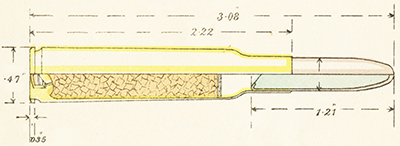
Whatever their type or variety, the Mausers quickly made a name for themselves. The American forces had already recognized the flat-shooting 7x57 mm cartridge while fighting the Mauser-armed Spaniards in Cuba during the Spanish-American War, but the ability to load quickly from a five-round stripper clip really caught the attention of the British. While the rear sight on the long Boer Mauser rifle is adjustable out to 2,000 meters, it cannot be moved laterally to account for windage. However, while this did not seem to have been an issue with the Boers, the British adopted a very intricate (and windage-adjustable) rear sight on the succeeding model of Lee-Enfield (the famous “Short, Magazine, Lee-Enfield” or SMLE) after the war, as well as incorporating a charger-loading system.
Aside from the different variants of the Model 1893 Mausers most often seen in photographs of Boer fighters, the second most popular longarm appears to be the standard British shoulder arm of the period—the “Long” Lee-Enfield and the obsolescent Lee-Metford. The latter, a bolt-action .303 rifle first adopted in 1888, fired a necked cartridge loaded with compressed blackpowder. It was named for its designer, James Paris Lee—the Scottish-born Canadian-American who also designed the 6 mm Winchester-Lee “Straight Pull” rifle that saw service in Cuba and at the 1900 Siege of Peking, in the hands of U.S. Marines. The shallow-groove Metford rifling system worked well with this cartridge, but when its propellant was changed to smokeless powder within a few years of the rifle’s adoption, the new cordite charge was found to erode the shallow-groove rifling. Accordingly, the new barrels were rifled with deeper grooves at the Royal arsenal at Enfield, and the resulting rifle was named the Lee-Enfield.

While most of the troops sent to South Africa from the British Isles had already transitioned to the Lee-Enfield, some, including various troops from the overseas dominions of the Empire, were still armed with Lee-Metfords. As was the custom before the adoption of “all-branches” rifles like the M1903 Springfield in America and the SMLE in Britain, the British cavalry were armed with various models of carbines, while the infantry carried long rifles. However, the Boers’ incredible mobility (they were nearly all mounted riflemen) led the British to adopt the same tactics, and they, too, hurriedly mounted infantrymen on horses, many of which were imported from either Argentina or America.
The British were often still using volley-fire tactics, and, indeed, their rifles were fitted with volley-fire sights on the left side. While the Lee rifles had a removable 10-round magazine (the cavalry carbine magazine held six cartridges), it took much longer to load than the Mauser, which loaded its five rounds using a stripper-clip system. The marksmanship skills of the average British soldier did not compare at all with the Boers, and this shortcoming, like the rifle, was seriously discussed and addressed after the war.

The third rifle type in the scale of popularity with the Boers was the Martini-Henry family of arms. When British intentions to reabsorb the Transvaal became apparent by the late 1880s, its government not only purchased used British arms wherever it could find them, but also contracted with the British firm of Westley-Richards to produce an updated version of the venerable .577/.450 rifle. This model not only had the elongated cocking lever of the Mark IV Martini, but also had a removable lock (very similar to the Gahendra system that was developed in Nepal at the Royal Armory), known as the Francotte system. The rifles produced by Westley-Richards were marked as such—“Made Specially for ZAR”—but were actually made in Belgium.

The Boers carried all types and sizes of Martinis, and, by the end of the 1900-1902 guerilla war phase, they also had some captured Martini-Metford and Martini-Enfield rifles and carbines, both chambered in .303—either black-powder or cordite—in their ranks. When the Irish who were working in the gold mines at Johannesburg volunteered as the “Irish Transvaal Brigade” in 1899 to fight alongside the Boers, they were issued Martini-Henrys. According to photographic evidence, at least some of the brigaders were still carrying Martinis in 1900, after having captured a number of Long Lees on the way to Ladysmith, and then having been issued Mausers during the siege of that same town.

One of the most unique arms to see service with the Boer republics was the single-shot Guedes rifle. Designed by a Portuguese army officer, the Guedes rifle had a distinctive tilting-block breech, and was chambered for the rimmed 8x60 mm cartridge. The Portuguese government contracted with the famed Austrian arms manufactory at Steyr in 1885 to have these rifles made, but then cancelled the order when they realized that magazine-fed repeating rifles had become the wave of the future. The rifles sat in Austrian warehouses until the mid-1890s, when the Transvaal bought at least 7,700 of them, and the Orange Free State acquired a few hundred from the ZAR (Zuid Afrikaansche Republiek—South African Republic). Some of the Transvaal Guedes rifles, like some of the Martinis, were crudely stamped with a “ZAR”—but on the top, rather than the side, of the receiver.

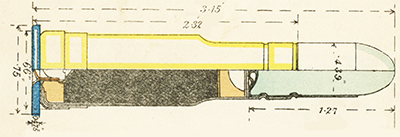
Other lesser-known modern firearms that could be found in the hands of Boer burghers were the 10-shot .303 Lee Speed rifle, the 6.5 mm Norwegian Krag, some 8 mm German Gewehr 88 “Commission” rifles and a few Model 1888/90 Mannlicher rifles. Arms that had played a part in the 1881 First Anglo-Boer War were also pressed into service, but to a very limited extent. First and foremost were British Snider .577 rifles and carbines, Martini-Swinburne .577/.450 carbines, and Westley-Richards “Monkey-Tail” percussion carbines and falling block rifles. Swiss rifles, like the obsolete Milbank-Amsler muzzleloader conversion, and the Model 1878 Vetterli—both in .41 Swiss rimfire—apparently were in evidence (but with limited ammunition), as were Model 1873 and Model 1876 American Winchesters, and even Model 1860 U.S. Spencer carbines. A few Kropatschek rifles and French Model 1874 Gras rifles also reportedly saw use by Boer commandos.
Handguns were a relative rarity among Boer officers, but, in addition to British-made Webley revolvers, foreign copies of Webleys and other European revolvers, several Boer officers carried the familiar “Broomhandle” Mauser pistol in 7.63x25 mm. In fact, it saw its first widespread military use in the Second Anglo-Boer War, and was carried by both sides. Boer Gen. Jan Christian Smuts and Boer Commandant Jacobus van Deventer carried Mauser pistols, and, most notably, a young Winston Churchill carried one in South Africa, while serving there as a war correspondent, and later as a volunteer in the South African Light Horse.
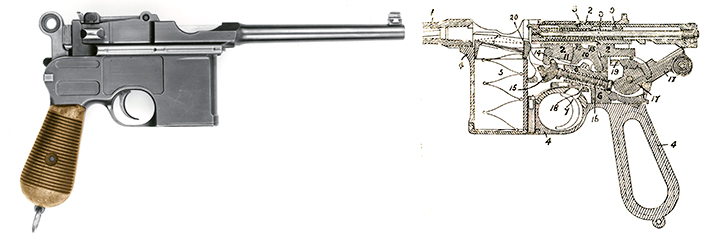
Perhaps the most unusual employment of any firearm during the war was the ingenious use of a Martini-Henry barreled action by the legendary “train wrecker” Oliver “Jack” Hindon. Born in Stirling, Scotland, Jack Hindon enlisted as a boy bandsman in the British army, but then deserted when he arrived in South Africa during the Zulu War of 1879. Hindon settled in the Transvaal and distinguished himself during the 1895 Jameson Raid, while fighting with the ZAR forces. By 1900, he had gained renown as the leader of a band of “train wreckers.” Captain Hindon and his men would scoop out the stone ballast under a railroad rail, place an explosive charge in the hollowed out hole, and then place a receiver of an upside down Martini-Henry in the hole, with its cut down 4" barrel shoved into the charge. The trigger guard on the action had already been cut off, so that the trigger rested right under the rail. When the locomotive of a British train passed over the mine, the rail would flex enough to depress the trigger, and fire a cartridge into the dynamite—blowing the train off the tracks.
The Boers had placed their faith in God and the Mauser, but had lost the war. Nonetheless, they actually won the peace. Within a few years of the end of the war, the British government (under pressure from popular opinion) had not only rebuilt the country, but had afforded much of the political power in the newly formed Union of South Africa to the Afrikaaners—albeit under the control of the British Empire. Respect for the Boers’ marksmanship and tactics resulted in an increased emphasis on rifle shooting in the British army, so much so that the shooting skills of the British Expeditionary Force of 1914 were able to successfully disrupt the invasion plans of the German army in their sweep through Belgium and Northern France—thus denying a quick German victory in the opening months of World War I.
The author thanks Keith Allen, Harris J. Andrews, III, and Jack McClure for their assistance in the preparation of this article. For further reading, Dr. Ron C. Bester’s Small Arms of the Anglo-Boer War, 1899-1902 is the most comprehensive and definitive work available on the subject, while both volumes of David C. George’s Carvings from the Veld not only show the magnificent carvings on the stocks of both Boer and British arms, but also contain fascinating details of the rifles’ usage.












